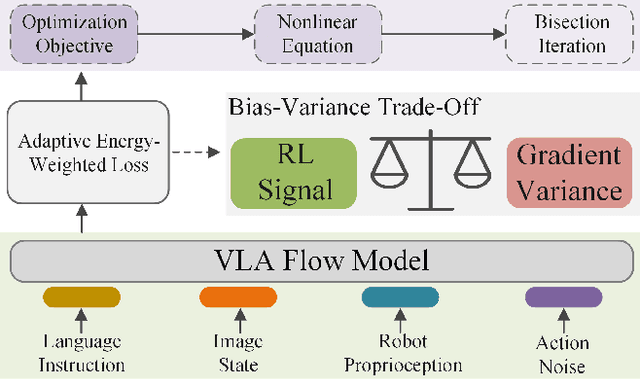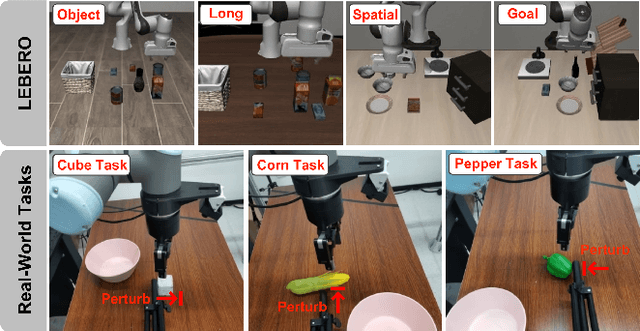Donglin Wang
Executable Analytic Concepts as the Missing Link Between VLM Insight and Precise Manipulation
Oct 09, 2025Abstract:Enabling robots to perform precise and generalized manipulation in unstructured environments remains a fundamental challenge in embodied AI. While Vision-Language Models (VLMs) have demonstrated remarkable capabilities in semantic reasoning and task planning, a significant gap persists between their high-level understanding and the precise physical execution required for real-world manipulation. To bridge this "semantic-to-physical" gap, we introduce GRACE, a novel framework that grounds VLM-based reasoning through executable analytic concepts (EAC)-mathematically defined blueprints that encode object affordances, geometric constraints, and semantics of manipulation. Our approach integrates a structured policy scaffolding pipeline that turn natural language instructions and visual information into an instantiated EAC, from which we derive grasp poses, force directions and plan physically feasible motion trajectory for robot execution. GRACE thus provides a unified and interpretable interface between high-level instruction understanding and low-level robot control, effectively enabling precise and generalizable manipulation through semantic-physical grounding. Extensive experiments demonstrate that GRACE achieves strong zero-shot generalization across a variety of articulated objects in both simulated and real-world environments, without requiring task-specific training.
Robust Online Residual Refinement via Koopman-Guided Dynamics Modeling
Sep 16, 2025Abstract:Imitation learning (IL) enables efficient skill acquisition from demonstrations but often struggles with long-horizon tasks and high-precision control due to compounding errors. Residual policy learning offers a promising, model-agnostic solution by refining a base policy through closed-loop corrections. However, existing approaches primarily focus on local corrections to the base policy, lacking a global understanding of state evolution, which limits robustness and generalization to unseen scenarios. To address this, we propose incorporating global dynamics modeling to guide residual policy updates. Specifically, we leverage Koopman operator theory to impose linear time-invariant structure in a learned latent space, enabling reliable state transitions and improved extrapolation for long-horizon prediction and unseen environments. We introduce KORR (Koopman-guided Online Residual Refinement), a simple yet effective framework that conditions residual corrections on Koopman-predicted latent states, enabling globally informed and stable action refinement. We evaluate KORR on long-horizon, fine-grained robotic furniture assembly tasks under various perturbations. Results demonstrate consistent gains in performance, robustness, and generalization over strong baselines. Our findings further highlight the potential of Koopman-based modeling to bridge modern learning methods with classical control theory.
Integrating Trajectory Optimization and Reinforcement Learning for Quadrupedal Jumping with Terrain-Adaptive Landing
Sep 16, 2025Abstract:Jumping constitutes an essential component of quadruped robots' locomotion capabilities, which includes dynamic take-off and adaptive landing. Existing quadrupedal jumping studies mainly focused on the stance and flight phase by assuming a flat landing ground, which is impractical in many real world cases. This work proposes a safe landing framework that achieves adaptive landing on rough terrains by combining Trajectory Optimization (TO) and Reinforcement Learning (RL) together. The RL agent learns to track the reference motion generated by TO in the environments with rough terrains. To enable the learning of compliant landing skills on challenging terrains, a reward relaxation strategy is synthesized to encourage exploration during landing recovery period. Extensive experiments validate the accurate tracking and safe landing skills benefiting from our proposed method in various scenarios.
VLA-Adapter: An Effective Paradigm for Tiny-Scale Vision-Language-Action Model
Sep 11, 2025Abstract:Vision-Language-Action (VLA) models typically bridge the gap between perceptual and action spaces by pre-training a large-scale Vision-Language Model (VLM) on robotic data. While this approach greatly enhances performance, it also incurs significant training costs. In this paper, we investigate how to effectively bridge vision-language (VL) representations to action (A). We introduce VLA-Adapter, a novel paradigm designed to reduce the reliance of VLA models on large-scale VLMs and extensive pre-training. To this end, we first systematically analyze the effectiveness of various VL conditions and present key findings on which conditions are essential for bridging perception and action spaces. Based on these insights, we propose a lightweight Policy module with Bridge Attention, which autonomously injects the optimal condition into the action space. In this way, our method achieves high performance using only a 0.5B-parameter backbone, without any robotic data pre-training. Extensive experiments on both simulated and real-world robotic benchmarks demonstrate that VLA-Adapter not only achieves state-of-the-art level performance, but also offers the fast inference speed reported to date. Furthermore, thanks to the proposed advanced bridging paradigm, VLA-Adapter enables the training of a powerful VLA model in just 8 hours on a single consumer-grade GPU, greatly lowering the barrier to deploying the VLA model. Project page: https://vla-adapter.github.io/.
Balancing Signal and Variance: Adaptive Offline RL Post-Training for VLA Flow Models
Sep 04, 2025



Abstract:Vision-Language-Action (VLA) models based on flow matching have shown excellent performance in general-purpose robotic manipulation tasks. However, the action accuracy of these models on complex downstream tasks is unsatisfactory. One important reason is that these models rely solely on the post-training paradigm of imitation learning, which makes it difficult to have a deeper understanding of the distribution properties of data quality, which is exactly what Reinforcement Learning (RL) excels at. In this paper, we theoretically propose an offline RL post-training objective for VLA flow models and induce an efficient and feasible offline RL fine-tuning algorithm -- Adaptive Reinforced Flow Matching (ARFM). By introducing an adaptively adjusted scaling factor in the VLA flow model loss, we construct a principled bias-variance trade-off objective function to optimally control the impact of RL signal on flow loss. ARFM adaptively balances RL advantage preservation and flow loss gradient variance control, resulting in a more stable and efficient fine-tuning process. Extensive simulation and real-world experimental results show that ARFM exhibits excellent generalization, robustness, few-shot learning, and continuous learning performance.
Long-VLA: Unleashing Long-Horizon Capability of Vision Language Action Model for Robot Manipulation
Aug 28, 2025Abstract:Vision-Language-Action (VLA) models have become a cornerstone in robotic policy learning, leveraging large-scale multimodal data for robust and scalable control. However, existing VLA frameworks primarily address short-horizon tasks, and their effectiveness on long-horizon, multi-step robotic manipulation remains limited due to challenges in skill chaining and subtask dependencies. In this work, we introduce Long-VLA, the first end-to-end VLA model specifically designed for long-horizon robotic tasks. Our approach features a novel phase-aware input masking strategy that adaptively segments each subtask into moving and interaction phases, enabling the model to focus on phase-relevant sensory cues and enhancing subtask compatibility. This unified strategy preserves the scalability and data efficiency of VLA training, and our architecture-agnostic module can be seamlessly integrated into existing VLA models. We further propose the L-CALVIN benchmark to systematically evaluate long-horizon manipulation. Extensive experiments on both simulated and real-world tasks demonstrate that Long-VLA significantly outperforms prior state-of-the-art methods, establishing a new baseline for long-horizon robotic control.
ReconVLA: Reconstructive Vision-Language-Action Model as Effective Robot Perceiver
Aug 14, 2025Abstract:Recent advances in Vision-Language-Action (VLA) models have enabled robotic agents to integrate multimodal understanding with action execution. However, our empirical analysis reveals that current VLAs struggle to allocate visual attention to target regions. Instead, visual attention is always dispersed. To guide the visual attention grounding on the correct target, we propose ReconVLA, a reconstructive VLA model with an implicit grounding paradigm. Conditioned on the model's visual outputs, a diffusion transformer aims to reconstruct the gaze region of the image, which corresponds to the target manipulated objects. This process prompts the VLA model to learn fine-grained representations and accurately allocate visual attention, thus effectively leveraging task-specific visual information and conducting precise manipulation. Moreover, we curate a large-scale pretraining dataset comprising over 100k trajectories and 2 million data samples from open-source robotic datasets, further boosting the model's generalization in visual reconstruction. Extensive experiments in simulation and the real world demonstrate the superiority of our implicit grounding method, showcasing its capabilities of precise manipulation and generalization. Our project page is https://zionchow.github.io/ReconVLA/.
GCHR : Goal-Conditioned Hindsight Regularization for Sample-Efficient Reinforcement Learning
Aug 08, 2025Abstract:Goal-conditioned reinforcement learning (GCRL) with sparse rewards remains a fundamental challenge in reinforcement learning. While hindsight experience replay (HER) has shown promise by relabeling collected trajectories with achieved goals, we argue that trajectory relabeling alone does not fully exploit the available experiences in off-policy GCRL methods, resulting in limited sample efficiency. In this paper, we propose Hindsight Goal-conditioned Regularization (HGR), a technique that generates action regularization priors based on hindsight goals. When combined with hindsight self-imitation regularization (HSR), our approach enables off-policy RL algorithms to maximize experience utilization. Compared to existing GCRL methods that employ HER and self-imitation techniques, our hindsight regularizations achieve substantially more efficient sample reuse and the best performances, which we empirically demonstrate on a suite of navigation and manipulation tasks.
Multi-Task Multi-Agent Reinforcement Learning via Skill Graphs
Jul 09, 2025Abstract:Multi-task multi-agent reinforcement learning (MT-MARL) has recently gained attention for its potential to enhance MARL's adaptability across multiple tasks. However, it is challenging for existing multi-task learning methods to handle complex problems, as they are unable to handle unrelated tasks and possess limited knowledge transfer capabilities. In this paper, we propose a hierarchical approach that efficiently addresses these challenges. The high-level module utilizes a skill graph, while the low-level module employs a standard MARL algorithm. Our approach offers two contributions. First, we consider the MT-MARL problem in the context of unrelated tasks, expanding the scope of MTRL. Second, the skill graph is used as the upper layer of the standard hierarchical approach, with training independent of the lower layer, effectively handling unrelated tasks and enhancing knowledge transfer capabilities. Extensive experiments are conducted to validate these advantages and demonstrate that the proposed method outperforms the latest hierarchical MAPPO algorithms. Videos and code are available at https://github.com/WindyLab/MT-MARL-SG
CEED-VLA: Consistency Vision-Language-Action Model with Early-Exit Decoding
Jun 16, 2025Abstract:In recent years, Vision-Language-Action (VLA) models have become a vital research direction in robotics due to their impressive multimodal understanding and generalization capabilities. Despite the progress, their practical deployment is severely constrained by inference speed bottlenecks, particularly in high-frequency and dexterous manipulation tasks. While recent studies have explored Jacobi decoding as a more efficient alternative to traditional autoregressive decoding, its practical benefits are marginal due to the lengthy iterations. To address it, we introduce consistency distillation training to predict multiple correct action tokens in each iteration, thereby achieving acceleration. Besides, we design mixed-label supervision to mitigate the error accumulation during distillation. Although distillation brings acceptable speedup, we identify that certain inefficient iterations remain a critical bottleneck. To tackle this, we propose an early-exit decoding strategy that moderately relaxes convergence conditions, which further improves average inference efficiency. Experimental results show that the proposed method achieves more than 4 times inference acceleration across different baselines while maintaining high task success rates in both simulated and real-world robot tasks. These experiments validate that our approach provides an efficient and general paradigm for accelerating multimodal decision-making in robotics. Our project page is available at https://irpn-eai.github.io/CEED-VLA/.
 Add to Chrome
Add to Chrome Add to Firefox
Add to Firefox Add to Edge
Add to Edge